Are you looking for exterior siding panels for the exterior wall of your home? And worried about whether panel siding is good for exterior walls? If you don’t know what and how to buy? So this article will really give you deep insight into the best different types of exterior siding panels.
Yes, sir, without a doubt! Depending on your needs, panel siding might be a good option for external walls. It is reasonably priced, simple to install, and available in a variety of materials to match your preferred aesthetic.
However, you might want to think about alternative solutions if you’re looking for something that will last longer and provide greater protection. But hey, panel siding should work if your only goal is to win over your neighbor’s cat.
Just keep in mind to assess the benefits and drawbacks before choosing, and don’t forget to consider the thoughts of any furry companions that might be evaluating your exterior design decisions!
Welcome to the world of exterior siding panels, one and all! You’re in for a treat whether you’re an experienced homeowner trying to update the exterior of your home or a beginner looking for the ideal siding solution.
To bring you the greatest and most distinctive kinds of exterior siding panels now available, we combed the world (or more specifically, the internet).
We have everything, from standard options like wood and vinyl to more unusual ones like stone veneer and metal. Hence, take a seat back, unwind, and get ready to learn how to choose the ideal siding panel for your house – obviously with a dash of comedy.
What is an exterior siding panel?
A type of material called an exterior siding panel is used to cover and protect a building’s exterior walls. It can improve the aesthetic appeal of a house or business building and acts as a barrier to the weather, such as rain, wind, and snow. Wood, vinyl, fiber cement, metal, and stone veneer are just a few of the materials that are used to make siding panels. It’s critical to carefully assess which siding panel option is the greatest fit for your personal needs and tastes because each material has a variety of special qualities, advantages, and disadvantages.
What To Consider When Choosing The Best Different Types of Exterior Siding Panels [ Buying Guide ]
There are numerous factors to consider when selecting various types of exterior siding panels for the external walls of your home or building. The following are important factors to keep in mind:
- Durability: Durability is the first and most crucial consideration. How durable are siding panels? Will it withstand all weather conditions and be impervious to moisture and insect damage?
- Maintenance: Siding repair is yet another crucial element. How much upkeep is necessary to keep the panels in excellent shape? Is it simple to clean and fix?
- Aesthetic Appeal: Aesthetics Are the Third Consideration. Do the siding panels complement the building’s design and architecture? And your neighbors are drawn to the siding panels. Will it make the curb appeal more or less appealing overall?
- Cost: Cost is the fourth consideration. How much do siding panels cost when installation and upkeep are taken into account? Is it affordable for you?
- Environmental Impact: The siding panels’ use of recycled or sustainable materials will have an influence on the environment. Will it harm the ecosystem in some way?
- Installation simplicity: The next consideration is installation simplicity. How simple is it to install siding panels? Is this a DIY endeavor or will you need to employ a professional contractor?
- Noise Reduction: Do siding panels help with noise reduction, especially if you live in a noisy area? This is a crucial question in noise reduction.
- Fire Resistance: This is yet another crucial element. Does the Siding Panel Have Fire Resistance? If you reside in a region where wildfires are a serious threat, this is extremely crucial.
By keeping all of these things in mind, you can choose the outside siding panel for your home that will offer long-lasting protection, match the aesthetic of your home, and be within your price range.
Also Read: Which Side Of The House Gets The Most & Least Sunlight?
list of the 9 best Different Types of Exterior Siding Panels
1. Wood Siding Panels

A type of exterior cladding constructed from wood is wood siding panels. They are fixed to the exterior walls of the home and provide protection against the elements while also boosting its visual quality.
There are several different types of wood siding panels, such as shingles, clapboard, board and batten, and tongue and groove. Many types of wood, including cedar, pine, spruce, and redwood, can be used to create them.
Because of their natural and timeless appearance, wood siding panels are a popular choice among homeowners, but they need to be maintained frequently and can be vulnerable to insect and rot damage.
PROS:
- Aesthetics: Wood siding panels offer a lovely, classic look that can improve a home’s curb appeal.
- Sustainability: Compared to some other siding materials, wood is a more environmentally responsible choice because it is a renewable and biodegradable resource.
- Insulation: Wood siding panels have strong insulation qualities that assist keep a house cool in the summer and warm in the winter.
- Simple to paint: Wood siding panels are simple to paint or stain to create the desired appearance.
CONS:
Maintenance: Wood siding panels need to be painted or stained on a regular basis since they are prone to rot, deterioration, and insect damage.
Cost: Wood siding panels can be pricey, especially if you choose premium components.
Fire hazard: Wood is quite flammable, making it a riskier choice in locations where there is a high likelihood of wildfires.
Installation: To avoid problems like warping, buckling, or cracking, wood siding panels must be installed correctly. This needs skill and experience.
2. Vinyl siding panels
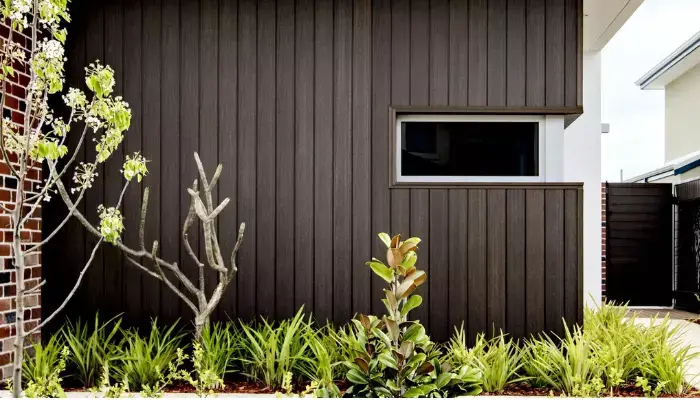
Vinyl siding panels are made using polyvinyl chloride resin, making vinyl siding panels a tough and low-maintenance option for protecting the exterior walls of a home from the elements.
Shingle, clapboard, and vertical panel designs are just a few of the colors, textures, and types of vinyl siding panels that are offered.
To produce a barrier that is impermeable to water, they are frequently constructed with overlapping edges.
Homeowners frequently choose vinyl siding panels because of their affordability, toughness, and low maintenance requirements. They can be utilized for both new construction and siding replacement.
PROS:
- Minimal maintenance: Vinyl siding panels are simple to clean and require very little maintenance.
- Cost-effective: Compared to other siding materials like wood or brick, vinyl siding panels are often less expensive.
- Durability: Vinyl siding panels can last up to 40 years or more and are resistant to decay, dampness, and insect damage.
- Energy efficiency: By minimizing heat gain in the summer and loss in the winter, vinyl siding panels can increase a home’s energy efficiency.
CONS:
Limited color options: A small selection of colors are offered for vinyl siding panels, which cannot be painted or stained.
Susceptible to fading: Vinyl siding panels are prone to fading as a result of exposure to sunshine and the elements over time.
Environmental issues: PVC, which is not biodegradable and can be damaging to the environment, is used to make vinyl siding panels.
Installation problems: Warping or buckling can occur when vinyl siding panels are installed incorrectly.
3. Fiber Cement Siding Panels
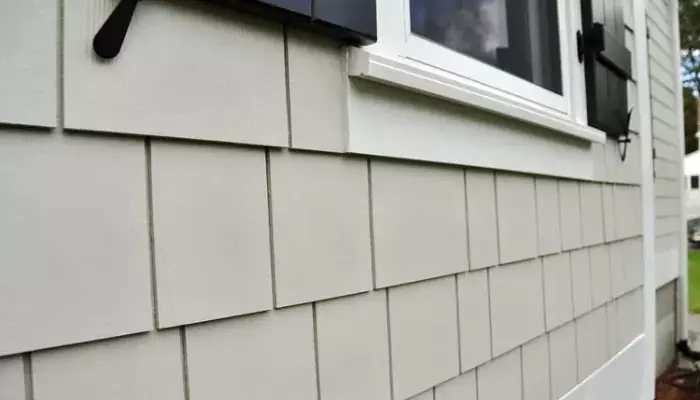
A combination of cement, sand, and cellulose fibers is used to create the outside cladding known as fiber cement siding panels.
They are made to be a tough and low-maintenance choice for shielding a building’s façade from the weather. Shingle, clapboard, and vertical panel designs are just a few of the colors, textures, and types of fiber cement siding panels that are offered.
They are resistant to rain, fire, insects, and rot and can replicate the appearance of natural materials like wood or stone.
PROS:
- Durability: Fiber cement siding panels can endure up to 50 years or more and are resistant to dampness, fire, insects, and rot.
- Minimal upkeep: Fiber cement siding panels are simple to clean and require little maintenance.
- Aesthetics: Fiber cement siding panels can imitate the appearance of natural materials like wood or stone because they come in a variety of hues and textures.
- Energy efficiency: By minimizing heat gain in the summer and loss in the winter, fiber cement siding panels can increase a home’s energy efficiency.
PROS:
- Cost: Siding panels made of fiber cement can be more expensive than siding made of vinyl or wood.
- Heavy: Fiber cement siding panels may need specialized tools and expert installation because of their weight.
- Installation problems: Fiber cement siding panels that are improperly installed may crack or sustain moisture damage.
- Environmental issues: The production of fiber cement siding panels can be wasteful and energy-intensive.
4. Metal Siding Panels
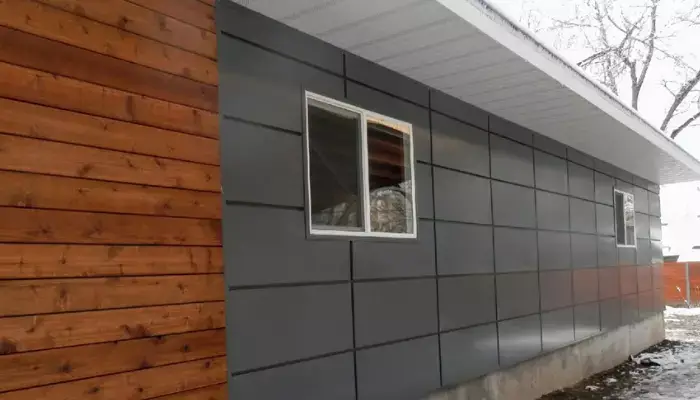
Metal materials, such as aluminum, steel, or zinc, are used to make metal siding panels, a sort of exterior cladding.
The building will be shielded from moisture, wind, and other external variables thanks to its long-lasting and robust construction.
Shingles, standing seam panels, and corrugated panels are just a few of the different styles, dimensions, and textures of metal siding panels.
They are well-liked for their contemporary, industrial aesthetic and may be employed on both residential and commercial structures.
PROS:
- Durability: Metal siding panels can endure up to 50 years or more and are resistant to dampness, fire, insects, and rot.
- Minimal maintenance: Metal siding panels are simple to clean and require little maintenance.
- Energy efficiency: By reflecting solar heat and lowering summer cooling bills, metal siding panels can help a home become more energy efficient.
- Aesthetics: In terms of aesthetics, metal siding panels can produce a contemporary, industrial impression because they come in a variety of hues and textures.
CONS:
- Cost: Compared to alternative siding materials like vinyl or wood, metal siding panels might be more expensive.
- Noise: When it rains or hails heavily, metal siding panels might make noise.
- Dents: Metal siding panels are readily dented and may be challenging to fix.
- Rust: Metal siding panels that aren’t properly maintained over time may rust and corrode.
5. Brick Siding Panels
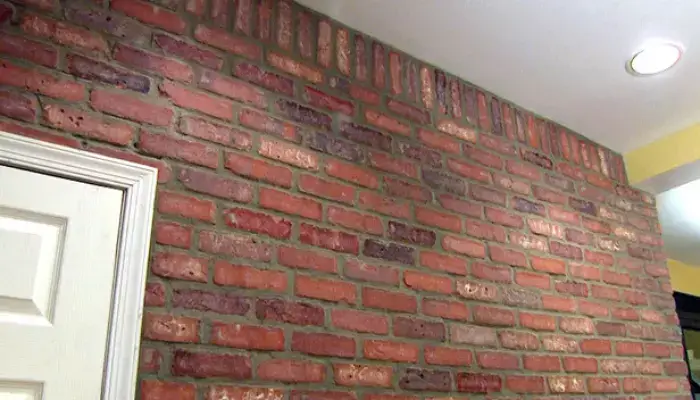
Brick siding panels are a kind of exterior cladding created from burned clay or other raw materials.
To generate a sturdy, long-lasting material, clay is molded into a rectangular shape and fired in a kiln. Brick siding panels are well-liked for their traditional, timeless appearance and their capacity to increase a home’s worth.
They come in a variety of hues and materials, from classic red to more contemporary tones like grey and black.
PROS:
Durability: Brick siding panels are renowned for their durability and, with proper upkeep, can last for generations.
Minimal maintenance: Other than the occasional cleaning, brick siding panels need little care.
Fire resistance: Brick is a non-combustible material that can assist a building to withstand fire damage.
Aesthetics: Brick siding panels’ timeless, traditional appearance can increase a home’s value.
CONS:
Cost: Compared to alternative siding materials like vinyl or fiber cement, brick siding panels are often more expensive.
Installation: Brick siding panels need to be professionally installed, which might increase the entire cost.
Weight: Brick siding panels may need additional support due to their weight, which will raise the cost of installation.
Limited design options: Restricted color and texture options: Brick siding panels may not be suitable for all design tastes due to their limited color and texture options.
6. Stone Siding Panels
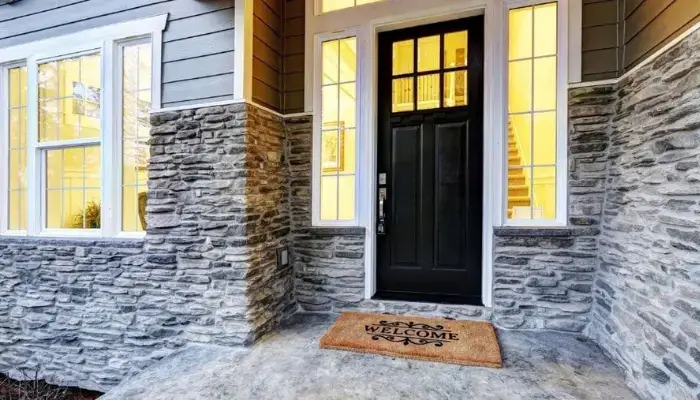
A material for exterior cladding that can be constructed from either natural or artificial stone is stone siding panels.
The panels offer homeowners a more useful and affordable alternative while imitating the appearance and texture of genuine stone.
Stone from quarries is used to create natural stone siding panels, whereas cement, aggregates, and pigments are used to create manufactured stone siding panels. Stone siding panels come in a wide range of hues, forms, and dimensions, making it simple for homeowners to select a style that complements the look of their home.
PROS:
- Aesthetics: Stone siding panels’ organic, natural appearance can give a house or structure more curb appeal and visual interest.
- Durability: Stone siding panels are incredibly strong and resistant to the elements and harsh weather.
- Minimal maintenance: Other than the occasional cleaning, stone siding panels require very little care.
- Fire resistance: Stone is a non-combustible substance that can aid in preventing fire damage to a building.
CONS:
Cost: Siding panels made of stone are often more expensive than siding panels made of vinyl or fiber cement.
Weight: Since stone siding panels are heavy, additional support may be needed, raising the cost of installation.
Limited design options: There aren’t many color and texture possibilities for stone siding panels, which may not fit everyone’s tastes in design.
Installation: Professional installation is necessary for stone siding panels, which might raise the entire cost.
7. Stucco Siding Panels

A combination of cement, sand, and water is used to create stucco siding panels, one type of exterior cladding.
The mixture is put in layers to a building’s outside walls before being finished and textured to achieve the desired appearance.
Stucco siding can be personalized with a variety of colors and textures, including smooth, rough, and patterned surfaces.
PROS:
- Minimal maintenance: Panels of stucco siding only need occasional cleaning with a power washer.
- Durability: Stucco siding panels are quite strong and can survive inclement weather, such as wind and rain.
- Aesthetics: Stucco siding panels come in a variety of colors and textures and can give a house or structure a sleek, contemporary appearance.
- Energy-efficient: Stucco siding panels can contribute to energy efficiency since they help to control the temperature within a structure.
CONS:
- Cracking: Panels of stucco siding are prone to cracking with time, especially if the building settles if the installation method was improper.
- Moisture absorption: If stucco siding panels aren’t properly maintained, they may absorb moisture, which could cause water damage and mold growth.
8. Stone Veneer Siding Panels

Natural stone can be replaced with lightweight, strong, and affordable stone veneer siding panels. In order to provide a genuine appearance of natural stone, they are constructed by slicing a thin layer of synthetic or natural stone and gluing it to a panel or backing material.
PROS:
- Offers natural stone’s look for less money
- Less difficult to install and doesn’t need a foundation
- Resistant to weather damage, insects, and fire
- The enduring and resilient choice for external cladding
- Has many different hues and textures.
CONS:
- The insulating qualities of some siding materials might not be as good.
- Periodic upkeep may be necessary to prevent moisture damage or fading.
- In harsh weather, artificial stone could not be as resilient as natural stone.
- If made from non-renewable elements, it could not be a sustainable choice.
- Maybe not as impact-resistant as other siding products.
9. engineered wood siding panels
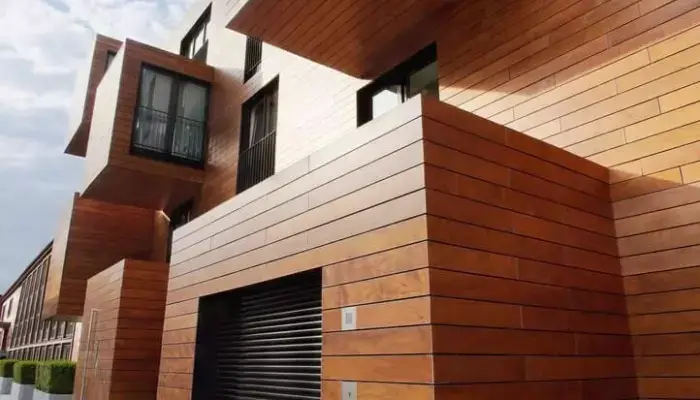
Engineered wood siding panels are created by joining wood fibers or strands with resin or other synthetic components to produce a strong, weatherproof product. The benefits and drawbacks of engineered wood siding are as follows:
PROS:
- Resembles the appearance of real wood siding, but is more reasonably priced.
- Can be stained or painted to suit any design desire
- Warp-, rot-, and insect-resistant
- Environmentally friendly materials may be used in manufacturing.
- Offered in a variety of designs, such as panel, lap, and shingle siding
CONS:
- Compared to other siding materials, it could need more upkeep, like painting or staining.
- In cases of severe weather, it can not be as resilient as other siding materials.
- Maybe not as impact-resistant as other siding products
- possibly less insulating than certain other siding materials
- Depending on the manufacturer may only come in a few colors.
Conclusion:
A crucial choice you must make for your property is the sort of exterior siding panel. It might have an effect on the value of your house as a whole, energy effectiveness, and curb appeal.
You can choose something that suits your demands and budget by taking into account aspects like cost, durability, upkeep, and preferred styles.
Whether you select siding panels made of vinyl, fiber cement, wood, stone veneer, or brick, be sure to work with a dependable manufacturer and skilled installer to get the best results.
FAQs about Different Types of Exterior Siding Panels
q1. Can I install exterior siding panels myself?
Ans. Some external siding panel types, such as vinyl and fiber cement, are simple to install and suitable for do-it-yourself projects. Some choices, meanwhile, including brick and stone veneer, demand expert installation.
q2. How do I need to maintain my wood siding panels?
Ans. For the purpose of avoiding rot and deterioration, wood siding panels need frequent maintenance. This entails maintaining the wood by cleaning, staining, and sealing it every few years as well as taking care of any moisture problems and minimizing soil contact.
q3. What is the best type of exterior siding panel for my home?
Ans. The ideal exterior siding panel for your home will rely on your spending limit, your personal style choices, and outside variables like the weather.
q4. Which Siding Panels Are Most Used For Exterior Walls?
Ans. It’s a popularity battle when it comes to siding panels for exterior walls. Wood and brick are traditional materials, whereas vinyl and fiber cement are cool youngsters. But hey, the party is also open to metal and stone veneer.
Tell Us In The Comments As Per You Which One Is The Best Exterior Siding Panel for your home
Additionally, don’t forget to read the other post on ideas for making houses, which will provide you with an insightful and helpful perspective.
